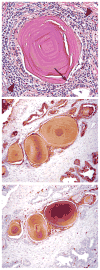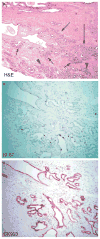Prostate cancer and inflammation: the evidence
- PMID: 22212087
- PMCID: PMC4029103
- DOI: 10.1111/j.1365-2559.2011.04033.x
Prostate cancer and inflammation: the evidence
Abstract
Chronic inflammation is now known to contribute to several forms of human cancer, with an estimated 20% of adult cancers attributable to chronic inflammatory conditions caused by infectious agents, chronic non-infectious inflammatory diseases and/or other environmental factors. Indeed, chronic inflammation is now regarded as an 'enabling characteristic' of human cancer. The aim of this review is to summarize the current literature on the evidence for a role for chronic inflammation in prostate cancer aetiology, with a specific focus on recent advances regarding the following: (i) potential stimuli for prostatic inflammation; (ii) prostate cancer immunobiology; (iii) inflammatory pathways and cytokines in prostate cancer risk and development; (iv) proliferative inflammatory atrophy (PIA) as a risk factor lesion to prostate cancer development; and (v) the role of nutritional or other anti-inflammatory compounds in reducing prostate cancer risk.
© 2011 Blackwell Publishing Limited.
Figures



References
-
- Siegel R, Ward E, Brawley O, Jemal A. Cancer statistics, 2011. CA Cancer J Clin. 2011;61:212–236. - PubMed
-
- Krieger JN, Nyberg L, Nickel JC. NIH consensus definition and classification of prostatitis. JAMA. 1999;282:236–237. - PubMed
-
- Brede CM, Shoskes DA. The etiology and management of acute prostatitis. Nat Rev Urol. 2011;8:207–212. - PubMed
-
- Cai T, Mazzoli S, Meacci F, et al. Epidemiological features and resistance pattern in uropathogens isolated from chronic bacterial prostatitis. J Microbiol. 2011;49:448–454. - PubMed
Publication types
MeSH terms
Substances
Grants and funding
LinkOut - more resources
Full Text Sources
Other Literature Sources
Medical

